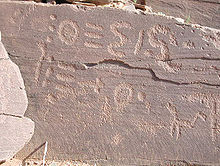Berber languages
[1][2] They comprise a group of closely related but mostly mutually unintelligible languages[3] spoken by Berber communities, who are indigenous to North Africa.[19] Tashlhiyt, Kabyle, Central Atlas Tamazight, Tarifit, and Shawiya are some of the most commonly spoken Berber languages.[20] Following independence in the 20th century, the Berber languages have been suppressed and suffered from low prestige in North Africa.[34][35][36][37] The use of Berber has been the subject of debate due to its historical background as an exonym and present equivalence with the Arabic word for "barbarian.In contrast, the split of the group from the other Afroasiatic sub-phyla is much earlier, and is therefore sometimes associated with the local Mesolithic Capsian culture.According to Peter Behrens and Marianne Bechaus-Gerst, linguistic evidence suggests that the peoples of the C-Group culture in present-day southern Egypt and northern Sudan spoke Berber languages.[46][47] The Nilo-Saharan Nobiin language today contains a number of key loanwords related to pastoralism that are of Berber origin, including the terms for sheep and water/Nile.This in turn suggests that the C-Group population—which, along with the Kerma culture, inhabited the Nile valley immediately before the arrival of the first Nubian speakers—spoke Afroasiatic languages.These approaches divide the Berber languages into Northern, Southern (Tuareg), Eastern, and Western varieties.[57][58] The exact population of speakers has been historically difficult to ascertain due to lack of official recognition.It claimed that 32 percent of Moroccans spoke a Berber language, including bi-, tri- and quadrilingual people.[92] In total, there are an estimated 3.6 million speakers of Berber languages in countries outside of Morocco and Algeria, summarized as follows: After independence, all the Maghreb countries to varying degrees pursued a policy of Arabisation, aimed partly at displacing French from its colonial position as the dominant language of education and literacy.This state of affairs has been contested by Berbers in Morocco and Algeria—especially Kabylie—and was addressed in both countries by affording the language official status and introducing it in some schools.[96] In 2002, following the riots of the Black Spring, Tamazight was recognized for the second time as a national language, though not as an official one.[99][100][32][22] Although regional councils in Libya's Nafusa Mountains affiliated with the National Transitional Council reportedly use the Berber language of Nafusi and have called for it to be granted co-official status with Arabic in a prospective new constitution,[101][102] it does not have official status in Libya as in Morocco and Algeria.[67] In linguistics, the phonology of Berber languages is written with the International Phonetic Alphabet, with the following exceptions:[104]The influence of Arabic, the process of spirantization, and the absence of labialization have caused the consonant systems of Berber languages to differ significantly by region.[15] Berber languages found north of, and in the northern half of, the Sahara have greater influence from Arabic, including that of loaned phonemes, than those in more southern regions, like Tuareg.[15][105] Most Berber languages in northern regions have additionally undergone spirantization, in which historical short stops have changed into fricatives.[125][16] When sentences have a verb, they essentially follow verb–subject–object word order, although some linguists believe alternate descriptors would better categorize certain languages, such as Taqbaylit.Specifics vary by language, but prefixation typically changes singular a- and ta- to plural i- and ti- respectively.For example, in multiple Berber languages, such as Figuig, a-ɣi ("buttermilk") is singular while am-an ("water") is plural.[122][130] There are a limited number of pre-nominal elements, which function similarly to pronoun syntactic heads of the noun phrase, and which can be categorized into three types as follows:[130] Verb bases are formed by stems that are optionally extended by prefixes, with mood, aspect, and negation applied with a vocalic scheme.[16][17] Some linguists have proposed opposing analyses of the word order patterns in Berber languages, and there has been some support for characterizing Taqbaylit as discourse-configurational.[citation needed] However, the household-related vocabulary in sedentary tribes is especially different from the one found in nomadic ones: whereas Tahaggart has only two or three designations for species of palm tree, other languages may have as many as 200 similar words.[144] These names may be precolonial non-African Romance loans, adopted into Berber languages through Arabic, rather than from Latin directly.F. W. H. Migeod pointed to strong resemblances between Berber and Hausa in such words and phrases as these: In addition he notes that the genitive in both languages is formed with n = "of" (though likely a common inheritance from Proto-Afro-Asiatic; cf.According to Peter Behrens (1981) and Marianne Bechaus-Gerst (2000), linguistic evidence suggests that the peoples of the C-Group culture in present-day southern Egypt and northern Sudan spoke Berber languages.[46][47] The Nilo-Saharan Nobiin language today contains a number of key pastoralism related loanwords that are of Berber origin, including the terms for sheep and water/Nile.This in turn suggests that the C-Group population—which, along with the Kerma culture, inhabited the Nile valley immediately before the arrival of the first Nubian speakers—spoke Afro-Asiatic languages.


TmazightNorth AfricaBerber diasporaBerbersLinguistic classificationAfro-AsiaticProto-BerberNorthernWesternTuaregEasternNumidianGuancheISO 639-2ISO 639-3GlottologKabyleCentral Atlas TamazightShilhaSenhaja de SrairGhomaraTarifitAyt SeghrouchenAyt WaraynShenwaShawiyaMzab-WarglaEast ZenatiZenagaTetserretEastern BerberTifinagh textTifinagh lettersAfroasiatic language familymutually unintelligibleBerberLibyco-BerberTifinaghBerber Latin alphabetArabic scriptRomance languagesdialect continuumverb–subject–object word orderMoroccoAlgeriaTunisiaBurkina FasoMauritaniaSiwa OasisWestern EuropeTashlhiytprestigeArabic languageKabyle languagepharyngeal fricativespharyngealized consonantChadicCushiticOmoticNames of the Berber peopleStandard Moroccan TamazightStandard Algerian TamazightTashelhitexonymArabicLinguasphere ObservatoryneologismKabylesChaouisProto-Berber languageGermanicRomanceMesolithicCapsian cultureC-Group cultureNilo-SaharanNobiin languageloanwordspastoralismKerma cultureNubianBerber orthographyZagoraLibyco-Berber scriptrock artTuareg peopleMaarten Kossmanntree modelZenatiNorthern BerberLanguages of Morocco2004 census2014 censusMoroccan censusEthnologueLanguages of AlgeriaShenwa languageOuargliTamahaqTugurtTidikeltGuraraMozabiteTawellemmetAir TamajeqNafusiGhadamésAwjilaDjerbiTamasheqMaghrebArabisationKabylieStandard Moroccan AmazighTamazight TVStandard Algerian BerberBlack Springnational languageofficialNafusa MountainsNational Transitional CouncilTripoliGaddafiTuareg languagesInternational Phonetic Alphabetpost-alveolar
